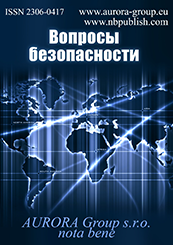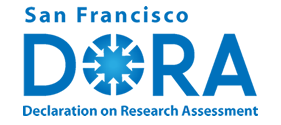Monitoring and civil control of security systems
Reference:
Degterev, A.K., Kucherik, G.V. (2025). Assessment of Hydrogen Sulfide Emission during Asteroid Impact in the Black Sea. Security Issues, 1, 1–11. https://doi.org/10.25136/2409-7543.2025.1.72998
Abstract:
The article considers the current problems of predicting the Earth's collision with asteroids and comets. Mathematical modeling of analyzed process of asteroids falling into oceans and seas is especially complex. Such models are based on solving the classical Euler-Navier-Stokes equations. The relevance of abovementioned problem is also justified by a number of features of the Black Sea basin, including the presence of a large amount of hydrogen sulfide and methane. An estimate of the concentration of hydrogen sulfide in the air during an asteroid fall into the Black Sea was obtained. It is shown that the main emission is associated with expected release of deep waters to the surface in the area of the fall, due to which the concentration of hydrogen sulfide in the surface layer of the atmosphere can reach one gram / cubic meter. In the cloud formed by the steam emission, the concentration of hydrogen sulfide does not exceed 0.04 gram/cubic meter. Based on obtained results of their study, authors come to conclusion that the content of hydrogen sulfide in the steam, and then in resulting cloud, is half the dangerous values at which the evacuation of the population is necessary. The principal difference between an asteroid hitting water and hitting a solid surface is that it does not immediately explode or melt but goes under water. In certain areas of the sea, the fall of an asteroid to the bottom can cause methane emissions, including due to the melting of gas hydrates. In this case, an explosive concentration of the gas-air mixture can be achieved. Perhaps the greatest danger is associated with the impact of the asteroid on the bottom and the subsequent exit of deep waters to the surface.
Keywords:
model calculations, safety, methane, comet, hydrogen sulfide, release of hydrogen sulphide, water wapor, crater, Black Sea, asteroid
Technologies and methodology of security systems
Reference:
Mulina, E.V., Ermakov, S.V. (2025). Paradigms of safety of classical and autonomous shipping. Security Issues, 1, 12–24. https://doi.org/10.25136/2409-7543.2025.1.73540
Abstract:
The subject of the study is the evolution of the paradigm of shipping safety. The purpose of the study is linguistic formalization and comparative analysis of the existing paradigm of classical shipping safety and a hypothetical paradigm of autonomous shipping safety, taking into account the evolutionary change of paradigms. The paper defines such concepts as shipping safety, shipping safety paradigm. The modern paradigm of classical shipping safety is analyzed by four safety objects. It is revealed that in this paradigm a human is the main and only safety object. It is shown that the modern paradigm of shipping safety is externally positioned as based on a set of many regulatory requirements, but in fact it is based on the natural sense of self-preservation, rational thinking, will, experience and knowledge of the crew members of vessels. The possible evolution of the shipping safety paradigm in the context of the development of the autonomous shipping is described. Some problems of this evolution are identified: the chaos of current methodologies, errors in remote assessment of the situation by an external captain, the psychological problem of interaction between classical ships with crews and autonomous ships. It is shown that a human in the paradigm of autonomous shipping safety will be naturally excluded from the number of safety objects, while the number of such objects will be replenished with information and technology, and the dangers to the ship and the environment will be less critical. The novelty of the study lies in the paradigmatic approach to the study of shipping safety, in the substantiation of the stages of development of autonomous shipping and the paradigm of its safety, as well as in the final structure of the hypothetical paradigm of autonomous shipping safety.
Keywords:
chaos of methodologies, periods of evolution, evolution of paradigm, safety paradigms, autonomous shipping, classical shipping, safety objects, shipping safety, information safety, safety of technologies
Person and citizen within security systems
Reference:
Kruglova, L.E., Marochkina, S.S., Kruglova, M.S. (2025). Formation of safety of public spaces for family recreation in resort regions. Security Issues, 1, 25–41. https://doi.org/10.25136/2409-7543.2025.1.73502
Abstract:
The author considers the problems of forming the safety of family recreation in the structure of public spaces of resort regions. The subject of the study is the system of factors of public safety of family recreation, statistical data on the most important areas requiring attention from local authorities, organizers of recreation and entrepreneurs working in the field of recreation and tourism. In recent years, the topic of creating comfortable public spaces in resort towns has become increasingly relevant. With the increase in the flow of tourists, as well as the number of families choosing such places for recreation, there is a need to understand and improve the conditions for a safe family stay. Modern cities are complex ecological systems, where attention to various social groups is of paramount importance for the creation of high-quality public space. The priority in the creation of comfortable public urban spaces is the tasks of an integrated approach to safe and affordable family recreation, including for different age and social groups of the population in the recreational and communicative environment. The results of a population survey on the state of the public safety system are presented, taking into account the requirements and wishes of families for modern resort areas. Suggestions are given to improve the conditions for safe family recreation, which will create more favorable conditions for a comfortable stay of families in the resort region. Urban public spaces should not only be arteries for movement, but also areas where people can interact, enjoy cultural events and exchange experiences. Cities integrate elements that promote socialization into their infrastructure: open-air cafes, art objects, green spaces, as well as places for sports and active recreation.
Keywords:
embankments, park areas, tourism, sociological survey, resort regions, urban environment, family vacation, safety factors, public spaces, territory
Administration and maintenance of security systems
Reference:
Komarov, A.A. (2025). The seasonality index, the accounting and registration of extremist crimes. Security Issues, 1, 42–58. https://doi.org/10.25136/2409-7543.2025.1.73456
Abstract:
The article is devoted to the study of the seasonality of extremist crimes and the peculiarities of their accounting and registration discipline in the Russian Federation. The object of the study is crimes of extremist and terrorist orientation, their dynamics and structural changes in the context of political crime. The main problem is related to the methodological limitations of traditional approaches to calculating the seasonality index, distortions in criminal statistics, as well as the impact of legislative changes (2014-2024) on data accounting. Particular attention is paid to the contradictions between the growth of extremist activity and a decrease in the overall crime rate, which reflects internal socio-political conflicts. The seasonality of extremist crimes, as a subject of research, is revealed through the prism of their political conditionality, which distinguishes them from ordinary acts. This indicates the need to separate the methods of analysis for different forms of political crime and to develop new criteria for their classification in criminal statistics. The analysis of criminal statistics from the Ministry of Internal Affairs and the Prosecutor General's Office of the Russian Federation for 72 months (2018-2024), the construction of dynamic series, the adaptation of economic formulas for calculating seasonality (multiplicative model), comparison with foreign studies (theory of everyday life, factor analysis), as well as criticism of legislative adjustments were used. Seasonal peaks of extremist activity (March-April) and terrorism (summer months) have been identified, related to domestic political events and climatic conditions, respectively. Statistical anomalies have been found in the crime accounting and registration discipline, including negative values of the increase in crimes and the impact of legislative changes (for example, amendments to Russian criminal legislation regarding CBR). It has been established that the growth of extremism correlates with electoral processes, and terrorism with the mobility of victims. Unlike competitors, the work offers a differentiated approach to the analysis of seasonality (division into "street" and "virtual" extremism), takes into account the exponential growth of crime and structural features of political motivation. The results highlight the need to reform criminal statistics methods and expand access to primary data for independent research.
Keywords:
Routine Activity Theory, cybercrime, Internet, terrorism, extremism, crime seasonality, criminal statistics, political crime, criminology, methodology
Legal support of national security
Reference:
Agamagomedova, S. (2025). Cash as an object of customs control: security issues. Security Issues, 1, 59–72. https://doi.org/10.25136/2409-7543.2025.1.72587
Abstract:
The subject of the study is the administrative and legal characteristics of cash as an object of customs control from the point of view of security. The analysis of the legal regulation of the activities of customs authorities in the field of control of cross-border cash turnover has been carried out. Based on the study of the legal definition of cash and the objects of customs control fixed in the customs legislation, it is concluded that there is a special area of customs control in relation to cross-border cash turnover. The author highlights the trends in the development of this area of control and supervisory activities of customs authorities and defines its place in the security system. Within the framework of the research subject, the relationship between two types of processes is determined: the process of ensuring the freedom of capital movement and the processes of countering the legalization of criminally obtained income and the financing of terrorism. When working on the topic, methods of comparative analysis, classification and systematization, and legal formalization were used. The novelty of the research lies in the fact that the author highlights the following features of customs control of cash turnover: its connection with currency control, regulation through international standards and national legislation, and involvement in the security system. It is concluded that there are two opposing trends in the modern regulation of cross-border cash turnover: the consistent development of ensuring the freedom of movement of cash and monetary instruments in the context of the development of economic integration and the simultaneous restriction of the conditions of such turnover for international and national security purposes. The analysis made it possible to conclude that the combination of financial and non-financial components in the considered area of customs control, to consider it as a measure of economic regulation and at the same time a ban due to countering the legalization of proceeds from crime.
Keywords:
FATF, financial control, currency control, Customs control, Financing of terrorism, legalization of income, digitalization, monetary instruments, cash on hand, jurisdictional functions
 This work is licensed under a Creative Commons Attribution-NonCommercial 4.0 International License.
This work is licensed under a Creative Commons Attribution-NonCommercial 4.0 International License.










 © 1998 – 2025 Nota Bene. Publishing Technologies. NB-Media Ltd.
© 1998 – 2025 Nota Bene. Publishing Technologies. NB-Media Ltd.




